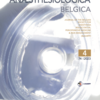BESARPP recommendations on responsible and sustainable use of inhaled anesthetics: No time TO WASTE
Bariatric Surgery, Gastric bypass, Sleeve gastrectomy, Chronic abdominal pain, Abdominal wall pain
Published online: Dec 21 2023
Dear readers,
In this issue of Acta Anaesthesiologica Belgica, the board of the Belgian Society of Anesthesiology, Resuscitation, Perioperative medicine and Pain Medicine publish practice recommendations on the use of inhaled anaesthetics in clinical practice1. This recommendations are accompanied by a structured, detailed overview of the actual knowledge based on an analysis of the current literature and allows us to adapt our practice accordingly. The recommendations are practice oriented and can act as guidance for the anaesthesia community.
First do no harm, this quote is a mainstay in health care and the basis of our professional activities. However, in a broader sense, we do harm to our planet most likely resulting in a climate change with potential inevitable consequences. Environmental sustainability is a crucial issue with consequences for the whole community, including the field of anaesthesiology, perioperative medicine, pain medicine and intensive care. As healthcare professionals, we are responsible for significantly reducing our negative environmental impact with the shortest possible time frame and implementing sustainable practices that benefit both, our planet and our patients, by maintaining and even enhancing quality of care and patient safety. Achieving this goal requires the cooperation of all stakeholders.
To address this, the European Society of Anaesthesiology and Intensive Care (ESAIC) developed The Glasgow Declaration, a roadmap to environmental sustainability within the fields of anaesthesiology, perioperative medicine and intensive care2. The recommendations of the BESARPP are complementary to this framework as they based on actual knowledge, can be implemented in local practice and do not interfere with the best possible patient care. Moreover, the BESARPP recommendations are also open for new technology developments which may reduce the environmental footprint of inhaled anaesthetics. The authors stimulate the use of modern technology like automated fresh gas flow in patients undergoing anaesthesia using inhaled anaesthetics. The actual recommendations on responsible use of inhaled anaesthetics will only be the first step. Actually, other parts of the ESAIC sustainable agenda are under consideration. In particular, the reduction of waste, the intensified use of re-usable materials and the effects of i.v. drugs on the environment are topics of intense consideration. Therefore, I assume that these recommendations are a starting point of our ongoing approach to combine patient safety and environmental sustainability.
References
1. Buhre W. Editorial: BESARPP recommendations on responsible and sustainable use of inhaled anesthetics: No time TO WASTE. AAB 2023,14,4:241.
2. Buhre W, De Robertis E, Gonzalez-Pizarro P.: The Glasgow declaration on sustainability in Anesthesiology and Intensive Care. Eur J Anaesthesiol. 2023 40: 461-464.
